History of the Study of Human Intelligence…
1850-1900:
1. Francis Galton, father of psychometrics and so many other things…
1900-1950:
2. Charles Spearman and the Discovery of the g Factor
1950-2000:
3. Wiliam Shokley and Dysgenics in the United States
4. Hans Eysenck and the Inequality of Man
5. “The Bell Curve” by Hernstein and Muray
2000- :
6. Richard Lynn, a pioneer in the footsteps of Francis Galton
7. Jean-Philippe Rushton and the r/K Zoologic Gradient
8. Tatu Vanhanen and the Political Implications of Racial Differences
9. Arthur Jensen and the Study of the g Factor
10. The courage of James Watson
11. Helmuth Nyborg and the Hormonal Influences
12. Linda Gottfredson and the social importance of intelligence variations
13. Robert Plomin and the emergence of GWAS scores
14. Emil Kirkegaard, Young, Gifted, Workaholic… Future Is Assured
1. Francis Galton, Father of Psychometrics and So Many Other Things…

First steps…
« I propose to show in this book that a man’s natural abilities are dirived by inheritance, under exactly the same limitations as are the form and physical features of the whole organic world »
Genius polymath with an IQ estimated at 200 (Terman, 1917a), the same intelligence as Blaise Pascal (Cox, 1926) Francis Galton Charles Darwin’s cousin with whom he shares his maternal grandfather Erasmus Darwin. With his pupil and then best friend Karl Pearson, he develops almost all the Western statistics used routinely today in statistical tests. He discovers ultrasound. He greatly advances meteorology by leaving us words like “anticyclone”, he develops in criminology the method of taking fingerprints, he is at the origin of the current methods of morphing, he is explorer and geographer, wrote best-sellings and invented the sleeping bag, he is also the father of differential psychology and one of the greatest geneticists of his time. He was ennobled in 1909 for his “invaluable contribution to human knowledge”.
He is not, however, the first to develop the concept of eugenics (even if he invent the term); Plato is already sketching out the main lines in 380 A.C.N. in “The Republic”, where he imagines a utopian state.
Sir Francis Galton (1822-1911) in 1840 (18 years old)
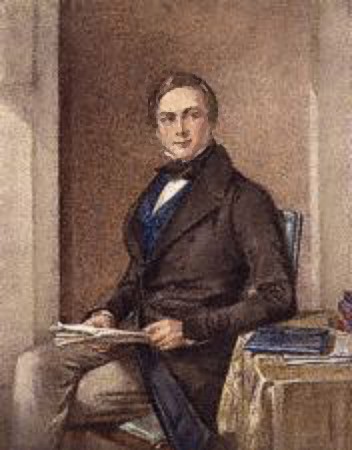
“Hereditary Genius” is a seminal work that marked his era as “The Origin of Species” by his cousin Darwin. Heritability of intelligence estimates are remarkably accurate in the light of the current studies. Hereditary Genius can be found in the foreground of Nietzsche’s private library.
Galton has a lot of intuitions.
“Hereditary Genius” demonstrates the highly genetic character of human intelligence and makes heritability estimates which, with a few nuances, are exactly the same as those found in advanced analyzes with current biotechnology tools. . Galton applies the “law of deviation from the mean” to what he calls “general cognitive ability”

Law of deviation from the average, “Hereditary Genius”, 1869
This distribution of general cognitive abilities is thus in Gaussian curve, like stature. He establishes degrees of intelligence.
Here is the distribution of intelligence following Galton. Upper case letters represent above-average intelligence while lower-case letters below average intelligence. A grade represents approximately 10.425 IQ points. Grade A represent an IQ of about 105, grade G an IQ of approximately 170.

Law of deviation from the average, “Hereditary Genius”, 1869
This distribution of general cognitive abilities is thus in Gaussian curve, like the size. He establishes degrees of intelligence.
Here is the distribution of intelligence following Galton. Upper case letters represent above-average grades and lower-case letters below average grades. A grade represents approximately 10.425 QI points. Grade A is centered on a grade of 105 of Q.I, grade G on a value of approximately 170.

Galton’s intelligence grades. Each grade is separated by 10.425 IQ points.

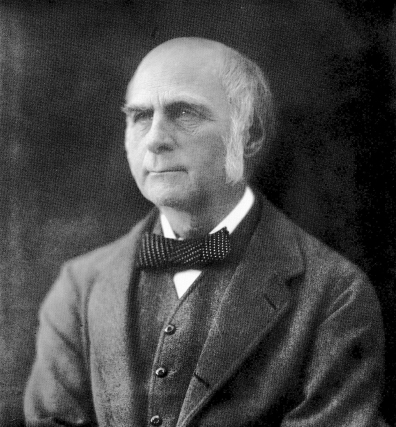 To learn more about Francis Galton, the excellent site galton.org
To learn more about Francis Galton, the excellent site galton.org
2. Charles Spearman and the Discovery of the g Factor
Charles Spearman (1863-1945) is the author of the empirical validation of Galton’s intuitions. Spearman studies the school results of children at this time and notes that those who have good marks in some subjects tend to be good in all subjects, while the less gifted in some subjects tend to be good in all subjects.
Spearman is particularly concerned that hearing discrimination tests seem to be correlated with other cognitive tests as well.
These tests of hearing discrimination consist in making two children sound different frequencies and ask which of the two sounds is the most acute. Then we gradually bring the frequencies closer to the sounds and we can thus determine the fineness of the auditory spectrum. Spearman develops a factor analysis method that allows him to extract a g factor of general intelligence.
Charles Spearman (1863-1945) will discover that a large proportion of so-called “intellectual faculties” is underpinned by a single factor, which he will call g for “general intelligence”.
Factor g is a biological, organic, person-to-person characteristic underlying all processes transiting through the central nervous system (ie ubiquitous cognitive functions)
Factor g is a measure of the power, complexity and efficiency of the central nervous system.
The g factor (= Spearman’s g) is measured in IQ units and it is usually he who is extracted from a conventional battery of tests.
 Illustration the g factor
Illustration the g factor
Spearman studies the school results of children at this time and notes that those who have good marks in some subjects tend to be good in all subjects, while the less gifted in some subjects tend to be good in all subjects.
Spearman is particularly interested in the fact that hearing discrimination tests seem to be correlated with other cognitive tests as well. These tests of hearing discrimination consist in making two children sound different frequencies and ask which of the two sounds is the most acute. Then we gradually bring the frequencies closer to the sounds and we can thus determine the fineness of the auditory spectrum. Spearman develops a factor analysis method that allows him to extract a g factor of general intelligence.
The phenomenon of positive inter-correlations in the set of mental abilities (called “positive manifold”) has been described as “probably the most reproduced result of all psychology” (Deary, 2000).
It is this phenomenon of inter-correlations that allows the extrapolation, from several tests, of a single figure, the Q.I, which is not only an “average of disparate results”.
Spearman also demonstrates that racial and especially African-European differences are mainly a difference of g.
For a longer discussion on the g factor, read “FAQ Intelligence“.
3.Wiliam B. Shokley and Dysgenics in the United States
William Shokley (1910-1989) was a Nobel Prize in physics for the development of the microprocessor. He is also known as the father of the Sillicon Valley and one of the most important figures of the 20th century for allowing the transition to the electronics era.

William Shokley, Nobel Prize in Physics for the invention of the transistor.
After studying the questions of IQ and intelligence and realizing the inherently genetic (genetic) nature of intelligence, Shokley will spend the rest of his life trying to warn the American population of the dangers that high birth rates African-Americans made the average intelligence run in the United States. He will say, “African Americans have an inextricably lower intelligence, about 15 percent (compared to Europeans) .I have been studying these issues for years and consider that my collaboration in familiarizing with these fundamentals is more important than my contribution in physics “. Shokley is also the man who invented and popularized the term “dysgenism”, the antonym of the term eugenics.
Like the countless prominent personalities who have had the courage and scientific integrity to talk about these topics without fear, it will suffer the ferocity of egalitarian ideologues.
Here, for example, is a 1974 debate with William Shokley on Q.I differences between races.
4. Hans Eysenck and “The Inequality of Man”
 Hans Eysenck, Ph.D., London University
Hans Eysenck, Ph.D., London University
One of Eysenck’s bestsellers is “The Inequality of Man”. It shows the importance of intellectual differences between individuals and Q.I in social accomplishment. In particular, he points to the intellectual differences between social classes and between Europeans and African-Americans. It shows, through the study of homozygous twins, that intelligence is highly heritable, both among Europeans, whose IQ is centered on 100, and among African-Americans, whose average is 85. It also deconstructs some beliefs that IQ is culturally biased, showing that Asian Asians perform as well as Europeans.
Eysenck was physically attacked at the beginning of a reading at the London School of Economics. Like many who had the courage to speak truth, he suffered the wrath of political activists.

“The Inequality of Man”, Eysenck, 1973.
A little earlier, in “The I.Q argument”, Eysenck clearly points to the genetic origin of the lower scores of African-Americans in all cognitive tests. Eysenck concluded that this difference in IQ is responsible for the differences in achievement between Europeans and African-Americans.
“The I.Q argument”, Eysenck, 1971
5. The Bell Curve by Hernstein and Muray
In 1994, Harvard psychology professor Richard Hernstein published with Charles Muray a book that became a bestseller. The Bell Curve demonstrates that differences in wages and socio-economic status between Europeans, Hispanics and African-Americans are largely caused by differences in intelligence. They also show that there is no discrimination against Hispanics or blacks and when IQ is controlled, average wages are equivalent.
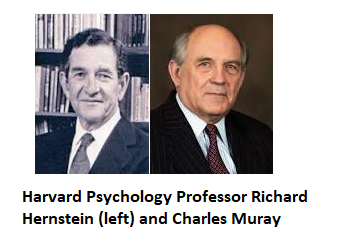
It might have been hoped that following Herstein and Muray’s demonstration that intellectual differences between races were responsible for differences in wages, socio-economic status, education, and other social parameters, sociologists who had believed for a long time these differences were due to cultural differences or the discrimination of Europeans against minorities would recognize that they were wrong and adopt the new paradigm. Some have done, like Darity and Myers (1998) “in controlling for the differences of Q.I, all the differences in terms of pay between Europeans and African-Americans are eliminated”. However, history shows us that new theories that undermine deep-seated and valued beliefs are typically ignored or slyly discounted. Many sociologists attacked “The Bell Curve” but they were not able to refute the central thesis.
 “The Bell Curve”, Hernstein et Muray, 1994
“The Bell Curve”, Hernstein et Muray, 1994
6. Richard Lynn, a pioneer in the footsteps of Francis Galton
Richard Lynn, born in 1930, is a doctor of psychology from the University of Cambridge.
He is Professor of Psychology at the Psychology and Economics Research Institute in Dublin and Professor and Head of the Psychology Department at the University of Ulster. He has won the Passingham Prize, the Cambridge University Award for Best Student of the Year in Psychology, and the Mensa Award for Best Performance (1985 and 1993) for his work on intelligence. .
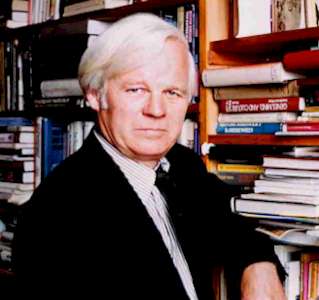 Richard Lynn
Richard Lynn
Richard Lynn will significantly advance the field of human intelligence and psychometrics.
He is the first to identify the Flynn effect and to explain it. The Flynn effect is a steady increase in Q.I in the last 40 years as a corollary of an improved diet. The Flynn effect will then take the name of “Flynn” because it is James Flynn who will popularize the discovery of Lynn.
Lynn identifies and quantifies the man-woman intellectual difference at about 5 Q.I points in adulthood, and is also the first to highlight the high Q.I of East Asian Mongoloid in the 1980s.
In 1994, Lynn began a study on genetic degradation in modern societies. In his book “Dysgenics”, he gathers the evidence, showing that the first eugenicists had reasons and that throughout the world the less talented individuals have the greatest number of children, consequence of a less good use contraception especially. There is also a genotypic degradation of what psychologists commonly call “conscientiousness”. This phenomenon, called “Dysgenism” by the Nobel Laureate William Shokley, causes a deterioration of the genetic quality by a decrease of the frequency of the alleles for a high intelligence and by a progressive increase of the alleles for a low intelligence.
 “Dysgenics”, seconde édition, 2011
“Dysgenics”, seconde édition, 2011
In 2001, Lynn publishes “Eugenics, a reassessment”, a remarkable book in which Lynn predicts the coming emergence of China as a global superpower. Lynn explains that embryonic selection will soon increase the average Q.I by 15 points per generation.
“Eugenics, a reassessment”, 2001 
In 2001, Lynn and Vanhanen’s “IQ and the wealth of nations” show that about 75% of the in GDP per capita variations, from an international point of view, are due to intellectual variations between the countries of the globe, ranging from an average IQ of 59 in Equatorial Guinea to 108 for Singapore. This discovery is central because it points to the biological foundations of development. Many sections of the site explain the data, including “IQ by country and economy“.
 “I.Q and the wealth of nations”, 2001, Lynn et Vanhanen
“I.Q and the wealth of nations”, 2001, Lynn et Vanhanen
In 2006, “Race Differences in Intelligence, an Evolutionary Analysis” is the largest collection of all intelligence measures among the main homo sapiens populations as detected genetically. Lynn establishes the average intelligence of the different races: Eastern Asians (105), Europeans (99), Southeast Asians (87), Native Americans (86), Pacific Islanders (85), North African and Middle Eastern Oriental (84), Sub-Saharan Africans (67), Bushmen (54), Great Apes (25). It demonstrates the high fidelity of these measures and their great predictive utility. This book also describes remarkably the evolutionary bases of the evolution of the intelligence from the first mammals while passing by the birds, then the primates and the evolution of the homo genus.
“Race differences in intelligence”, 2006, Lynn

In 2006, “IQ and Global Inequality” is published, it’s an updated version of “IQ and the wealth of nations”, in which Lynn and Vanhanen show that much of the social variation around the world is underpinned by differences in IQ between populations and between nations.
 “I.Q and global inequality”, 2006
“I.Q and global inequality”, 2006
In 2008, Lynn published “The Global Bell Curve. Race, IQ and Inequality Worldwide”, in tribute to The Bell Curve (Hernstein and Muray). Lynn demonstrates that regardless of the multi-ethnic country around the world, the social hierarchy remains strictly determined by the average IQ. See the chapter of this site “Worldwide Hierarchy”
 “The Global Bell Curve”, 2008, Lynn
“The Global Bell Curve”, 2008, Lynn
7. Jean-Philippe Rushton and the r/K Zoological Gradient
J.P. Rushon 
J.P. Rushton applies the r / K zoological gradient to the homo sapiens species and demonstrates that Africans are more R selected than Europeans who are more R selected than East Asian.
See “Rushton Evolutionary Perspective” on this site.
“Race, evolution and behavior”, JP Rushton, 2000 
Linda Gottfredson and J.P. Rushton

8. Tatu Vanhanen : The Political Consequences of Racial Differences
Tatu Vanhanen is a professor at the University of Tampere, Finland. He is also the father of Finnish Prime Minister Mati Vanhanen.

Tatu Vanhanen in 2009
In addition to working as a co-author with Richard Lynn in “IQ and the Wealth of Nations” (2001), “IQ and Global Inequality” (2006) and “Intelligence, an Unifying Consctruct for the Social Science” (2012) Vanhanen focus on the link between IQ and democracy. He demonstrates in “The Limits of Democratization” (2009) that the Democratization Index (ID) is strongly correlated with the national average IQ and concludes that a high level of intelligence in a population is needed to allow the emergence of a democratic system.
 “The limits of democratization”, Tatu Vanhanen, 2009.
“The limits of democratization”, Tatu Vanhanen, 2009.
Vanhanen demonstrates that a high level of intelligence is necessary for the emergence of a democratic system.
9. Arthur Jensen and ‘The g Factor’
Arthur Jensen is a professor of psychology at the University of California. He is considered one of the most prominent psychologists of the 20th century and has won numerous awards. He is among others the inventor of the “Jensen’s box”, used to measure reaction times.
Arthur R. Jensen, then a professor at the University of California

Jensen’s major work is “The g Factor” in which he dissects and actualizes Spearman’s discovery of a single factor of general intelligence.
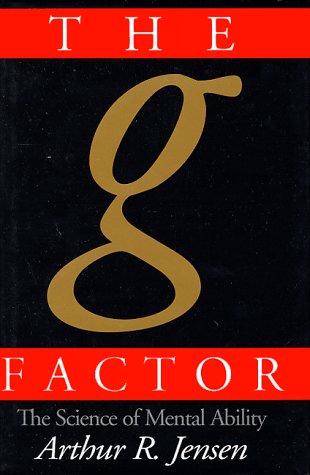 “The g factor”, 1998, Arthur Jensen.
“The g factor”, 1998, Arthur Jensen.
In 2006, Jensen explores the relationship between mental chronometry and intelligence

“Clocking the mind”, 2006, Jensen
10. James Watson’s Courage
In 2007, James Watson, Nobel Prize in Medicine for the discovery of the helical structure of DNA, one of the most important contemporary scientific personalities, made a notable outing by the media.
In an interview with the Sunday Times, he explains that the future of Africa can only be seen pessimistically, because “the basic assumption of all our development aid is that Africans would have the same intelligence as Europeans. , while it is clearly shown that this is not really the case “.

James Watson, one of many contemporary Nobel laureates aware of racial differences in terms of intelligence and the importance of these issues for our future
11. Helmuth Nyborg and the Hormonal Influences
Helmuth Nyborg is Professor of Developmental Psychology at the University of Aarhus, Denmark. He particularly studied the links between hormones and intelligences, and sexual differences.
In 2005, he published an article in the journal Personality and individual differences entitled “Sex-related differences in general intelligence, brain size and social status” in which he points out the existence of a sexual difference of 5 points from IQ to advantage of men. This difference had already been demonstrated by Lynn, who had shown that this slight masculine cognitive advantage was the mere theoretical consequence of the larger male brain and the correlation of 0.45 between cranial capacity and general intelligence.

In 2012, Helmuth Nyborg published two important articles. The first,”The decay of Western civilization: Double relaxed Darwinian Selection”, examines the Western intellectual deterioration that is taking place while the Afro-Maghreb populations are growing in Europe.
In a secound article, “Migratory selection for inversely related covariant T-, and IQ-Nexus traits: Testing the IQ/T-Geo-Climatic-Origin theory by the General Trait Covariance model”, Nyborg points to the existence of racial differences in the secretion of various hormones, including testosterone, and the reverse link found between this hormone and IQ.
12. Linda Gottfredson and the Social Importance of Intelligence Variations
Linda Gottfredson (Ph.D., professor at the University of Delaware) is an American sociologist and psychologist who broke with the recognition of the importance of intelligence in professional performance and the importance of race differences in terms of ‘intelligence.

It was at the initiative of Linda Gottfredson that was written the “Mainstream Science on Intelligence“, signed by all the big names in the field of intelligence (Raven, Catell, Flynn, Rushton …), published in the Wall Street Journal.
Q.I average per trade (percentile 10, 25, 50, 75 and 90 marked).
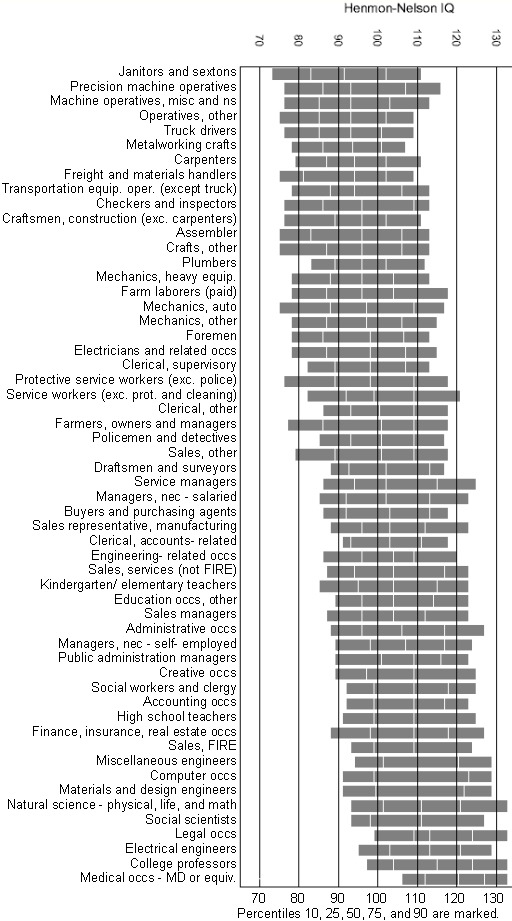
Some studies and presentations (pdf)…
“Resolute ignorance on race and Rushton” Gottfredson Linda (2013) Personality and Individual Differences 55, 218–223.
“Présentation succinte du facteur g” Gottfredson Linda (2013) International Society for Intelligence Research, Melbourne, Australia.
“The sociology of biological intelligence” Gottfredson Linda (2011) Hans J. Eysenck Lecture International Society for the Study of Individual Differences, London.
13. Robert Plomin and the Emergence of GWAS Scores
Robert Plomin (PhD, professor at King’s College London) is one of the most cited psychologists of the 20th century.
He won the Dobzhansky Memorial Award (2002; Behavior Genetics Association), the William James Fellow Award (2004; Association for Psychological Science) and the Lifetime Achievement Award (2011; International Society for Intelligence Research). Plomin is first and foremost known to have conducted the most comprehensive studies on identical twins as well as the most important GWAS intelligence studies to date, allowing the discovery of more than 1000 genes involved in general intelligence (g or IQ ).

The GWAS study published in Nature (2018) is a big step. For the first time a significant portion of a person’s intelligence can be predicted by his genome, from birth. The IQ estimation is obtained by calculating a “polygenic score” based on the effect (positive or negative) of the different alleles related to intelligence. One of the surprises in these GWAS studies on intelligence was the smallness of the effect of individual alleles. It was not expected to find so many genes involved in intelligence, each having a very small individual effect (<1 IQ point).
As might be expected, the frequency of these alleles increasing intelligence is parallel to the racial IQ hierarchy. East Asians have the highest frequency in alleles for high intelligence, followed by Europeans. Africans have the lowest frequencies of these alleles.
This confirms the first results of the racial differences in allelic frequencies obtained by Piffer in 2015.
These polygenic scores for intelligence also open the way to embryonic selection.
Genome-wide association meta-analysis in 269,867 individuals identified new genetic and functional links to intelligence Nature Genetics, 50, pages 912-919 (2018).
In October 2018, it appears “Blueprint, how DNA makes us how we are” in which Plomin explains the fundamental importance of DNA on intelligence and personality, and the lack of effect of family and socio-educational environment on these parameters. It shows how GWAS scores will reliably predict someone’s personality and intelligence from birth through genetic analysis.

14. Emil Kirkegaard, Yong, Gifted, Workaholic… Future is Assured
Emil Kirkegaard (born in 1989) is a young Danish, a former student of Helmuth Nyborg at Aarhus University. Brilliant hands-on, he is passionate about intelligence and differential psychology. He is recruited by the Ulster Institute for Social Research. In just a few years of activity, he already has a hundred publications to his credit in major journals, all open-source, dealing with national variations in intelligence, racial differences, sexual, social importance of intelligence (Kirkegaard develops the factor S, equivalent for the social factor g intelligence) or the impact of immigration.
 Emil Kirkegaard and James Flynn at the International Society for Intelligence Research (ISIR), 2017.
Emil Kirkegaard and James Flynn at the International Society for Intelligence Research (ISIR), 2017.
Follow Emil Kirkegaard on Twitter
Like many scholars who have studied intelligence and racial or sexual differences, Emil Kirkegaard has suffered the animosity of many egalitarian ideologues and of different medias.

